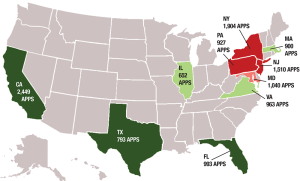
States in dark green sent significantly more applications than last year, while those in light green registered a slight increase. States in red sent significantly fewer applications than last year, indicative of a larger trend of decreased applications from the Northeast.
Application totals for the Class of 2019 remained nearly identical to the previous year, despite changing national trends regarding demographics and high school graduation rates.
Regular decision applications were due Saturday, Jan. 10, but were accepted until Monday, the first business day after the due date. As of Jan. 13, the number of regular decision applications across Georgetown’s four undergraduate schools totaled 19,427, nine fewer than the 19,436 applications that were received at the same point last year.
“The theme is the applicant pool remains steady in the face of declining high school graduate pool. That’s basically the environment,” Dean of Undergraduate Admissions Charles Deacon said. “Being even was good. We wanted to hold the pool between 19,000 and 20,000.”
Georgetown College received 11,510 applications compared to 11,551 for the Class of 2018; the McDonough School of Business saw 3,322 applications, similar to its total of 3,305 last year; the School of Foreign Service collected 3,513 applications, up from 3,439; and the School of Nursing and Health Studies received 1,041 applications, a decrease from the 1,141 applicants in 2014. Deacon explained these changes as natural variation, particularly with the specialized nature of the NHS.
Continuing a 10-year trend, women composed nearly 60 percent of the applicant pool, with 11,463 applicants, while 7,963 men applied to the university. Black applicants declined from 1,875 to 1,848, Hispanic applicants remained stable from 2,341 to 2,345 and Asian-American applicants increased slightly from 3,332 to 3,382.The university also received more applications from international students, with 2,248 this year compared to 2,188 last year.
At least nine applications were received from each of the 50 states. North Dakota was the only state not to have a student admitted during the early action period.
The largest number of applicants came from, in descending order, California, New York, New Jersey, Maryland and Florida. However, New York, New Jersey and Maryland, along with the other states of the Middle Atlantic and Northeast region of the United States, saw decreased application numbers, while California, Florida and Texas sent more applications than last year.
“[The trend is] largely declining white students in that part of the world. Those have been the primary feeders, the largest feeder states,” Deacon said. “Fortunately, for Georgetown, international [students], California, Florida and Texas have moved significantly up the list, and that’s where the population growth is coming from. Fortunately, we have a brand that’s visible in the growing areas to offset the declining areas where it’s traditionally been.”
The peak high school graduating class in the United States came in 2011: the number of high school graduates since that year has declined by five percent. During that same period, Georgetown’s application numbers have increased by a total of two percent.
The overall acceptance rate is expected to stabilize at a similar level to last year’s 16.3 percent. During the early action acceptance period in December, Deacon explained that admissions committees chose to reserve more space for students applying in the regular cycle, leading to a small decline in that acceptance rate.
The lower early acceptance rate flies in the face of a national trend among elite institutions to accept more students early. A recent Bloomberg article explained that early acceptances privilege affluent students in comparison to the regular decision process, since they make up a larger proportion of the early pool.
“The implication of that is significant. The more people you take early, the more likely there is to be a higher percentage of paying students, and the more you’re squeezing out at the other end. That would be a cynical way of reducing the amount of financial aid,” Deacon said. “It’s just another example of admissions becoming a business. We’re philosophically similar to where we were twenty years ago, saying that we should be student-centered, rather than institution-centered.”
Decisions for the regular application period will be released near the end of March.




















